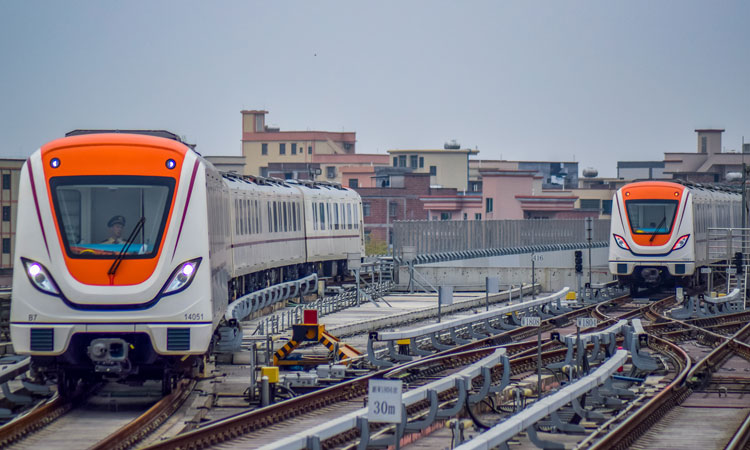Intelligent urban rail transit systems for the modern world
Posted: 16 July 2020 | Wang Xiaoqiang | No comments yet
Modern urban rail transit systems should operate with low energy consumption but with high efficiency. Huawei can improve these systems by implementing digitalisation with its ICT technologies. Wang Xiaoqiang, Solution Director for Transportation at Huawei, explains more.


Urban rail transit is the most convenient and safe mode of transportation within cities. In recent years, its advantages of low energy consumption and high efficiency are widely recognised on an international level.
To maximise the core advantages of urban rail transportation, a growing number of countries are developing this mode and establishing ICT-enabled applications to provide more convenient passenger transport services.
LTE technology is currently the most advanced wireless communications technology defined by 3GPP.
However, emerging economic and technical trends are presenting new challenges to ICT construction in the urban rail sector, for instance there are now higher and more diversified requirements on urban rail operational management, train-to-ground wireless communications networks need to be more reliable, secure and have larger transmission bandwidth, and advances in IP-based and broadband networks, plus the rapid growth of IP services such as CCTV and multimedia advertising, the bandwidth utilisation needs to be improved, and highly reliable networks constructed.
LTE technology is currently the most advanced wireless communications technology defined by 3GPP. It is a future-oriented technology for train-to-ground wireless communications. But how can the requirements of urban rail DCS networks be fully met?
In order to solve all these challenges, Huawei has the following sub-solutions suitable for smart urban rail:
Urban Rail Cloud solution
In order to support a multi-line centralised operation, one ICT platform, fast responses, Huawei has high service reliability, higher operational efficiency, and openness and compatibility.
Urban Rail LET-M Solution
In order to support Fully Automatic Operation (FAO), unified bearing of multiple services, Huawei solution has high reliability, up to 9-level QoS Smooth handover, Easy O&M, visualised dispatching.
Urban Rail Agile IP Network Solution
In order to support IP-based systems and applications, broadband transmission channels, unified bearer network that reduces the OPEX. Huawei Solution has reliable network, multi-service unified bearer, forward compatibility.
Next-Generation Urban Rail DCS Solution
For this solution, we use dedicated-frequency LTE network. The long-distance coverage of a single base station Atomic GPS + 1588 V2 clock, and high reliability design. Huawei urban rail solutions are serving more than 100 lines, and 2,000+ km length worldwide.


Building reliable, converged, and simplified private wireless networks for train-to-ground communications: Huawei’s TDD 1.8 GHz LTE-M solution
Ninety metro lines in China have already deployed Huawei’s Time Division Duplex (TDD) 1.8 GHz Long Term Evolution Machine-Type Communication (LTE-M) private network solution to build a more secure and reliable train-to-ground communications private wireless network. The network efficiently carries Communications-Based Train Control (CBTC), trunking, the Passenger Information System (PIS), and Closed-Circuit Television (CCTV) services.
TDD 1.8 GHz LTE-M standard development background
China’s urban rail multi-line network ranks first in the world. By the end of 2018, 5761.4km of urban rail lines (22 per cent of the global total) were put into operation in the Chinese mainland and transported 21.07 billion passengers. Under such circumstances, the CBTC, voice dispatching, PIS, and CCTV applications support the secure, reliable, and proper operations of urban rail networks where the wireless communications platform implements the key function – data connection.
A traditional wireless communications solution uses four networks in two modes to carry related services. Three Wi-Fi networks are used to carry CBTC, PIS, and CCTV services over public frequency bands, but are vulnerable to interference, which may even cause unexpected train stoppages. Meanwhile, limited Wi-Fi coverage distance means that multiple devices are required, complicating maintenance, while poor overall network performance during high-speed train movement makes it difficult to speed up the network, holding back transport innovation. Furthermore, a narrowband Terrestrial Trunked Radio (TETRA) network, which bears trunking services, can’t support the functions of smart urban rail and intelligent devices, including video calls, task dispatching, and multimedia services.
To address the pain points of traditional wireless communications solutions, China officially released the LTE-M standard in 2016, strictly defining the capability requirements for carrying CBTC, trunking, PIS, and CCTV services. LTE-M technology offers three significant advantages:
- Reliability: dedicated frequency bands avoid interference from public signals; dual-network redundancy backup
- Convergence: unified bearing of multiple services; 9-level Quality of Service (QoS) mechanism that ensures CBTC is the highest priority
- Simplification: up to 1.2km coverage radius of a single base station with easy deployment and maintenance, requiring no devices between two urban rail stations.
By the end of 2019, more than 130 urban rail lines in 40 cities across China had chosen to build LTE-M networks to carry CBTC, trunking, PIS, and CCTV services. Among them, Huawei has helped urban rail customers in 36 cities build LTE-M private networks for 90 lines with its world-leading LTE solution.
TDD 1.8 GHz LTE-M application prospects
In 2020, Huawei plans to launch the visualised IPH solution for metro lines, adopting unattended driving and the enhanced Machine Type Communication (eMTC) Internet of Things (IoT) solution that does not require manual inspection based on the TDD 1.8 GHz LTE-M standard.
The industry chain of TDD 1.8 GHz LTE-M is developing rapidly, guided by clear spectrum specifications and industry standards. In just five years, approximately 10 vendors are now able to provide the TDD 1.8 GHz LTE-M solution, working alongside dozens of on-board terminal and trunking terminal vendors. Huawei’s solution has completed Interoperability Tests (IOTs) with mainstream CBTC, PIS, and CCTV vendors. As these tests suggest, the solution can be successfully applied in customer train-to-ground communications.
In 2020, Huawei plans to launch the visualised IPH solution for metro lines, adopting unattended driving and the enhanced Machine Type Communication (eMTC) Internet of Things (IoT) solution that does not require manual inspection based on the TDD 1.8 GHz LTE-M standard.
In the international market, the development of broadband urban rail train-to-ground communications is accelerating. Huawei’s TDD 1.8 GHz LTE-M solution has been replicated worldwide: it has been commercialised by urban rail in Australia, and by light-rail in Ethiopia and Angola. Construction in the Southern Pacific, Central Asia, and Africa is ongoing. Huawei will continue to innovate its TDD 1.8 GHz LTE-M solution for urban rail to enable ubiquitous connectivity and facilitate the rapid development of the urban rail industry worldwide.
Zhengzhou Metro: The first metro line to use LTE-M
Line 1 of the Zhengzhou metro network commenced operations in 2013. This line adopted LTE-M to carry PIS and CCTV services for the first time, achieving a stable train-to-ground wireless transmission of 8 Mbit/s in the downlink and 6 Mbit/s in the uplink. This marked the first adoption of real-time HD PIS in the urban rail sector. In the opinion of customers, compared with other technologies, LTE has advanced capabilities in network capacity, coverage, anti-interference, and high mobility. Such capabilities help enhance customer confidence in deploying Huawei’s LTE-M solution for metro construction in the future.
Chongqing Metro: The first set of metro lines to bear CBTC services
Chongqing Metro Line 5 (opened in 2017) and Loop Line (opened in 2018) use LTE-M that features interference-free licensed frequency band, dual-network 1+1 backup, highly reliable seamless switchover, multi-service QoS, and other technologies, to provide the highest quality assurance for CBTC services, enabling agile operations across these two major metro lines. At the same time, Beijing Subway Yanfang Line and Nanjing Metro Line S9 began operations by deploying LTE-M to carry CBTC services.
Guangzhou Metro: The first metro line to use the LTE-M trunking network
The Branch Line of Guangzhou Metro Line 14 began operations in 2017. Here, an LTE-M wireless network carries voice trunking, video backhaul, train status monitoring, ICT application platforms, and other communications services required for metro operations and management. The network provides multiple dispatching modes, including point-to-point calls, group calls, and Public Address (PA).
Case Study: The Wenzhou Rail Transit Line S1
On 23 January 2019, Wenzhou Rail Transit Line S1 was officially put into operation, making Wenzhou the 33rd city in the Chinese mainland to have operated rail transportation. Furthermore, it is the first rail transit line in China that migrated production services to the cloud and was awarded in 2018 the Best Informatization Practice by China Association of Metros (CAMET).
The Wenzhou urban rail transit network plans to adopt a two-layer architecture: suburban (S) lines of the regional suburban-commuter rail transit system and metro (M) lines of the inter-city large-capacity system. By 2020, the network will consist of three commuter rail lines (155.26km) and three metro lines (80.03km), totaling 235.29km. On this basis, the future-oriented rail transit network will include three commuter rail lines and four metro lines, covering 381.51km.
Challenges for traditional distributed architecture
The ISCS is a large-scale system that integrates distributed computers and electromechanical equipment. By adopting the traditional three-level control and two-level management architecture, the system includes multiple subsystems, such as central integrated monitoring, equipment maintenance and network management, station integrated monitoring, depot/stabling yard integrated monitoring, as well as simulation and training systems.
Huge investment and low resource utilisation
The ISCS has a high hardware cost as it requires independent deployment of 40-50 real-time servers, historical servers, station servers, and other equipment at the OCC, station, and depots. In addition, the server and computing resource utilization has remained less than five per cent for a long period, resulting in a huge waste.
Long deployment period and high costs
The ISCS consists of many NEs with high maintenance costs. Moreover, independent procurement of servers and dispatch workstations suffers slow material arrival, and causes heavy commissioning and deployment workload, long service rollout and deployment period, as well as high implementation costs.
ISCS cloud solution meets service requirements
Huawei uses the FusionSphere cloud platform to develop an ISCS cloud solution based on its deep understanding of customer requirements and traditional ISCS architecture. Furthermore, the solution adopts the same service logical architecture as that of the traditional solution, while being deployed on virtual machines (VMs). In addition, the backbone transmission network solution employs the MLPS-based 3-hierarchy networking design based on the industry traditional solution that features single-ring dual nodes and link aggregation.
The ISCS cloud solution deploys Huawei’s high-performance FusionCube 9000 in the OCC equipment room. Instead of requiring external storage equipment and switches, the appliance integrates blade servers, distributed storage equipment, and network switches. It also pre-integrates distributed storage engines, virtualisation platforms, and cloud management software, to enable on-demand resource allocation and linear expansion. Multiple physical blade servers of FusionCube 9000 are virtualised into a computing resource pool (cluster), ensuring highly reliable services on the virtualisation platform, while services are deployed on the cloud platform. Service applications are properly planned and deployed between different FusionCube 9000 subracks in the OCC, allowing the active and standby service VMs to run in different subracks, to prevent single point of failure (SPOF) and improve system reliability.
According to the solution, a FusionCube 9000 is installed in the depot equipment room, on which an ISCS DR cloud is deployed. The cloud works in active/standby mode with the OCC cloud in preparation of taking over businesses and providing services when the OCC system is faulty, ensuring service continuity. Additionally, the simulation and service training systems can also be deployed on the DR cloud.
The ISCS cloud solution deploys workstations (at elevated stations) or station servers (at underground stations) to ensure services can be downgraded when the station is disconnected from the center. When the backbone link is faulty, the workstation or station server takes over local services and stores service data locally in real time. After the backbone link recovers, the service data stored during the failure can be synchronised to the central cloud platform.


Line S1 opening showcases cloud-based solution benefits
Wenzhou Rail Transit Line S1 started trial operations on 1 October 2018 and began passenger-carrying operations on 23 January 2019. So far, the ISCS cloud platform has been running with no problems, showing the official application of the cloud computing technology in core production services of urban rail.
The cloud-based solution benefits have been gradually highlighted during service deployment and rollout.
Fast service rollout
The cloud platform enables fast service provisioning. Compared with the traditional independent deployment mode at each station, the solution shortens service rollout time by 20 days and ensures that rail transit lines open on time.
Reduced hardware investment
The cloud-based hardware requires 45 per cent less investment. The solution supports on-demand capacity expansion in additional lines according to resource usage during practical operations, further utilising resources and saving hardware investment. As a result, the device power consumption is reduced by more than 60 per cent, and the equipment room space is saved by over 70 per cent.
Fewer O&M personnel
In the future, it is hoped that each city will build its own unified ICT-based multi-rail-line network platform to support the rapid development of rail transportation using cloud computing and big data technologies.
The traditional architecture requires approximately 50 O&M personnel on a line due to scattered devices, as well as heavy commissioning, O&M workload, and high risks.
However, the cloud-based solution with centralised resources requires only four to five cloud management personnel, thereby greatly reducing labour costs.
The further integration between cloud computing technology and urban rail services also transforms urban rail cloudification from single to multiple domains. In the future, it is hoped that each city will build its own unified ICT-based multi-rail-line network platform to support the rapid development of rail transportation using cloud computing and big data technologies.
To find out more about Huawei’s digital solutions in railway, click here.
Related topics
Digitalisation, Signalling, Control & Communications, Technology & Software, Wi-Fi








